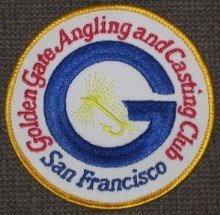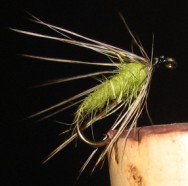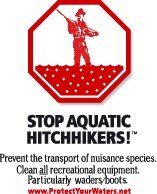Madison River Out Of Shape
try a "stiff hackle"
SLY WOULD LOVE IT!
 --The day is gray, the rain is very small, there are thin spots in the clouds, breakfast is done, Da Ford is warmed up, the opener is tomorrow. Off to the park for a final check on the rivers.
--The day is gray, the rain is very small, there are thin spots in the clouds, breakfast is done, Da Ford is warmed up, the opener is tomorrow. Off to the park for a final check on the rivers.-- With the recent re-discovery of the soft hackle fly, we offer a local variant that is often used early in the season on Yellowstone rivers -- "the Stiff Hackle Nymph."
-- This fly grew out of discussions with Sylvester Nemes in the late 70's. We discussed the necessary conditions for a soft hackle to transform itself into a stiff hackle. The decision then, and now, 'when a bit of twinkle is necessary in the hackle!' This is just the situation that exists now. The Firehole River is barely fishable, the 'tea-colored' water allows a bit of light, and any fly with a hint of reflection will do well. This is not the flash of tinsel or of other synthetic materials, but just a subtle bit of 'lightness' to separate this offering from the debris still suspended in the Firehole River.
-- The fly is simple to tie, effective in several colors, and useful in river conditions like we are experiencing now. This will be in the box tomorrow - along with some soft hackles of course. The body can be caddis green, or peacock herl. The hackle is the best grade dry fly hackle that you have - and that's the recipe.
-- Taper the body to a 'fat' front. Sly was always talking about the little tennis ball at the head of the fly to keep the soft hackle from matting down along the body. This is still necessary with the stiff hackle, but not so pronounced. White hackle can be used, but we prefer feathers with a silver or light gray cast to them. Great Blue Heron would be perfect if it were legal.
-- Dyed seal is excellent for the body, as is angora goat. The hackle should extend past the end of the body & hook bend, and one, (at most two,) turns are all that is necessary. The first flies we tied had a fine copper wire rib - worked OK, but did not seem to be in keeping with the original idea. This one is a success without much adornment at all.
-- This fly requires soaking to fish properly and, in a pinch can be greased to float. It is possible to 'cast dry' the fly, grease it and fish the same fly through the terminal stages of a caddis hatch. (Of course this means that you are not catching many fish.)
-- Sink tip lines are best to get this fly down, or a bit of weight, if you care to, on a floating line and leader. This is the way we fish it. Swing it all the way to the bank; there is no need for guessing - takes are positive.
-- SLY WOULD LOVE IT!




.jpg)







No comments:
Post a Comment